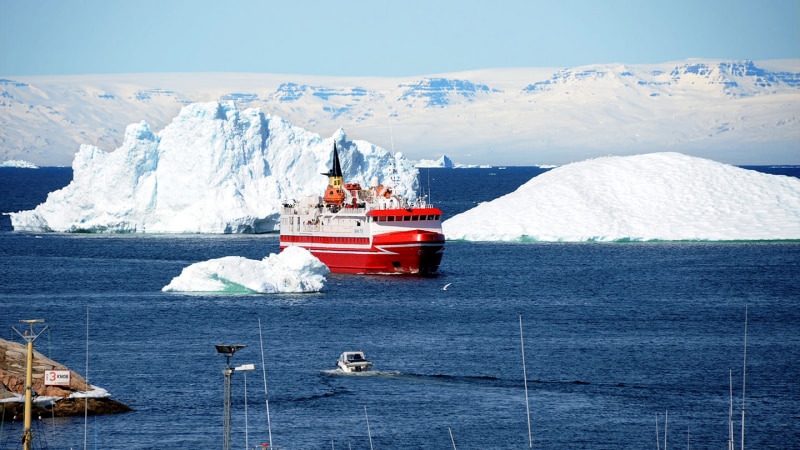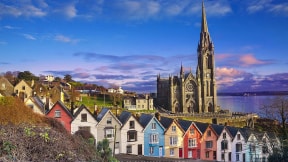A guide to cruising to Greenland

Quick insights
- Whale watching, Inuit dog sledding and Viking history are a few things you can experience while cruising to Greenland.
- Cruises to East Greenland, an isolated region with challenging terrain, may appeal to adventure seekers.
- Some West Greenland cruises allow travelers to explore Greenland’s towns, marine life and icebergs from the comfort of a large cruise ship.
On a cruise to Greenland, you might see towering icebergs, glaciers and the Northern Lights. Due to the ice, most cruise lines only operate in the summer. With the limited season, some cruises need to be booked more than a year in advance, especially if you want your preferred cabin or access to potentially cheaper prices.
With some planning, you can likely find a cruise itinerary to experience Greenland’s wildlife, culture, landscapes or whatever piques your interest. Our guide to cruising to Greenland breaks down some things to know as you plan your voyage to this unique destination.
The basics of cruising to Greenland
Greenland cruises can offer a curated experience of the world’s largest island. Planning the right cruise for you takes some research. Below, we’ve outlined a few things you may consider before going on a cruise to Greenland.
Culture, landscapes and wildlife
The eastern side of Greenland has a range of geological features, including mountains, fjords (narrow inlets of the sea between two high cliffs) and icebergs. Within this dramatic landscape, you may spot polar bears, musk oxen, artic foxes and reindeer among other wildlife.
East Greenland is sparsely populated, with a few remote settlements where many locals still practice Inuit cultural traditions like dog sledding, hunting and fishing. Specialized cruise ships often need to navigate large ice fields to make landfall on this side of the island.
The western side of Greenland has a more accessible coastline, and the region has a cosmopolitan atmosphere where modern and traditional lifestyles blend. Home to some of the island’s larger towns, it offers ample opportunities to immerse yourself in Greenland’s culture.
West Greenland’s relatively mild climate supports a wider range of vegetation and wildlife compared to East Greenland, and many travelers spot marine mammals including several species of whales while traveling the coastline.
Ice and your itinerary
Even in summertime, ice is a potential concern when cruising Greenland. Icy waters sometimes prevent or delay ships from making their planned stops or excursions.
Some ships in Greenland receive polar classification ratings—ranging from PC1 (strongest rating) to PC7—that indicate a ship’s strength and ability to operate in icy conditions. Expedition cruises that operate along the iciest coastline in Greenland may use polar-rated ships and list their ship ratings on their website. Contact the ship line if you have questions.
Most conventional cruise ships aren’t polar rated, which is one reason why these ships tend to stick to West Greenland. There may be times when these large cruise ships are unable to make any of their planned stops due to icy conditions.
Daylight hours
If you’ve never visited Greenland, you may not know that daylight hours can vary dramatically, depending on the time of year. In the summer, there’s 24 hours of daylight in much of Greenland. In winter, large portions of the country experience the reverse, 24 hours of darkness.
Arriving for your cruise
Travelers may want to arrive at least a day before their cruise. In the event of a flight cancellation or delay, the extra day may still allow them to arrive at their cruise’s port in time for the departure. For cruises that require international travel, some travelers may prefer to arrive as early as two days before a cruise’s departure.
Note that international travel to Greenland requires a valid passport. For stays under 90 days, you need a passport that’s valid for at least six months beyond your departure date. Depending on your situation, you may need additional travel documents.
Timing cruises to Greenland
From knowing how far in advance to purchase the cruise to selecting the right cruise travel dates, timing can be an important consideration when planning a Greenland cruise.
Here’s a breakdown of when cruise lines usually operate in Greenland:
- Peak season: The peak season for cruises is from June to August. Mild summer weather typically allows visitors to see wildlife, experience local cultural festivals and more.
- Shoulder season: Shoulder season—the time between peak season and the offseason—takes place in early June and late September. Cruises during shoulder season may be less crowded and more affordable.
- Offseason: October through May is the offseason when harsh conditions prevent most cruise lines from operating.
Availability for cruises may be limited as the peak season approaches. For larger cruise ships, if you book at least nine to 12 months in advance, you may have more cabins to choose from and access to better pricing.
If you’re planning a cruise during the height of peak season or a smaller expedition cruise with a unique itinerary, you may want to book as far as 12 to 18 months out.
Potential itineraries for Greenland cruises
Cruise itineraries in Greenland may have specific themes and focuses, from Viking history to outdoor adventure to the Northern Lights. Regardless of the itinerary’s focus, cruises tend to travel either the eastern or western coastline due to differences in their accessibility.
Here are a few features you may find on cruise itineraries for West Greenland and East Greenland.
Cruising West Greenland
Due to its more accessible ports, conventional cruise liners usually operate on the western side of Greenland. Here are some other features you may find in cruises to West Greenland:
- Stops: West Greenland cruises may stop at several major towns, including Sisimiut, Qaqortoq and Nuuk (Greenland’s capital).
- Varied activities: The western side of the island may offer a greater range of activities for excursions, including cultural tours, art galleries, museums, restaurants, hiking and more. There may be excursion opportunities to view icebergs at Ilulissat Icefjord or go whale watching in Disko Bay.
- Wildlife sightings: Due to the milder climate in West Greenland, marine life flourishes, making it a prime destination for spotting whales, seals and more.
- On-board amenities: Designed for comfort, large cruise ships are often outfitted with multiple dining options, spas, fitness rooms and recreational facilities. Some cruises may have onboard experts who lead educational talks and other learning opportunities on subjects like geology, history or marine biology.
Note that you may also find expedition cruises in smaller ships operating in West Greenland.
Cruising East Greenland
Cruises along East Greenland are generally in small expedition ships. These specialized ships are designed to navigate the region’s icy conditions. Due to East Greenland’s rugged coastline and limited port facilities, many expedition cruises use smaller vessels for shore landings.
These are just a few features of expedition cruises in East Greenland:
- Dramatic landscapes: With mountains, fjords, icebergs and Artic scenery to explore, East Greenland cruises may appeal to travelers who want excursion opportunities packed with adventure.
- Remote locations: There are some Inuit villages you may be able to visit—some of which are only accessible for a few months a year—where many traditional cultural practices are still kept.
- Focus on expeditions: Some cruises offer expeditions to hike, kayak, tour glaciers or have a close encounter with wildlife. On some expeditions, you may be accompanied by armed patrols to guard you from polar bears.
- On-board amenities: Cabins are sometimes more compact than on traditional cruise ships. Ships often have amenities like dining rooms with a scheduled meal service, snack bars, observation decks and lounges. Some ships may have experts in glaciology, history and more who lead educational programs and provide enrichment for passengers.
In summary
Many Greenland cruises immerse you in the country’s culture, history, landscape and wildlife. Between Greenland’s icy waters and variations in daylight hours, booking the right cruise can take research and planning. Many cruises along West Greenland stop in the country’s biggest towns and offer the comforts and amenities of traditional cruise ships. Available activities may range from city tours to whale watching excursions.
Special expedition ships tend to operate in the waters of East Greenland. These cruises are typically designed to appeal to adventurous travelers who want to explore the region’s rugged terrain. Accommodations may be more compact than on large cruise ships.



